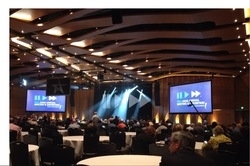Events
Creating a Culture of Giving in Your Association

The Sunday morning keynote session kicked off in true Nashville style with original, live music encouraging attendees to seize the moment as their own. ASAE announced several exciting announcements including a new membership structure, a new accessibility and meetings policy and expansion of their CareerHQ.com site, hosted by our very own Boxwood Career Solutions.
Creating a culture where “givers” succeed was the message behind author and professor Adam Grant’s presentation, based on his new book, “Give and Take: A Revolutionary Approach to Success.”
Grant, the youngest tenured and highest-rated professor at The Wharton School, shared three reciprocity styles that people generally fall under: givers, matchers and takers. Givers are the people who have a desire to help others and give of themselves, matchers are people who look for quid pro quo. They’ll do for you, if you do for them. Takers, just as the name implies, are those who take from those around them.
Givers are the type of people associations should seek as employees and board members, Grant said, but they often fall into the bottom tier in terms of performance because of their tendency to help others, even to their own detriment.
While that is the case for many givers, Grant explained that “the more givers you have, the better companies do.” Givers are also found in the very top tier of companies, when their giving tendency is properly channeled.
The key, he explained, is creating a culture where givers are encouraged to give in ways that have a high impact, with a low cost to the giver. He offered five tips to associations looking to make their organizations more giver-friendly.
Get the right people on the bus. This also means, Grant said, that you need to make sure you screen out the takers, thus keeping the wrong people off the bus. And givers don’t necessarily have to be the agreeable, friendly personality types that many would associate with a giving personality. It’s important to remember that some takers can be very agreeable, while many givers may seem disagreeable upon first impression. References from peers and those working under a candidate, and behavioral and situational interviews can help you identify a giver from a matcher or a taker.
Redefine giving. Help your givers realize that they don’t have to sacrifice their own needs in order to help others. “Five minute favors” as Grant calls them, can be as simple as making an introduction or giving a favorable review to a giver who might not be likely to too their own horn.
Change your reward system. Ask yourself: Does your success make other people better?
Create a culture of help. Grant shared that 75-90 percent of helping starts with a request, yet people hesitate to ask. “Willingness to ask for help, differentiates failed givers from successes,” he said. In a culture of help, Grant said that takers often become givers when offers of help are a visible part of a culture.
Who should you ask? When looking for help with making new connections, Grant suggested that our dominant ties, those friends and colleagues you used to be close within the past, but have lost touch with today, can be your best advocates.
What are you doing to encourage and support your givers, and turn the takers in your organization into givers in the process?

